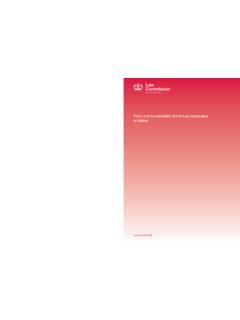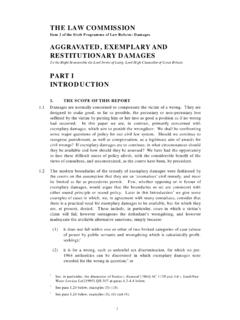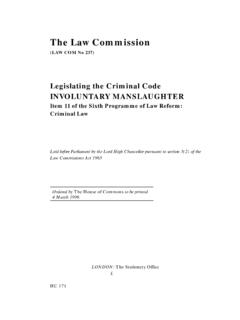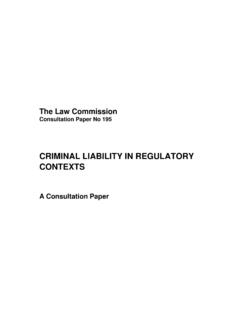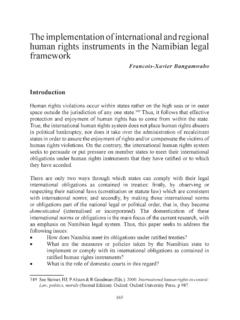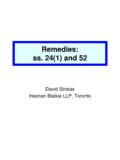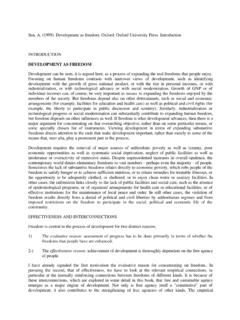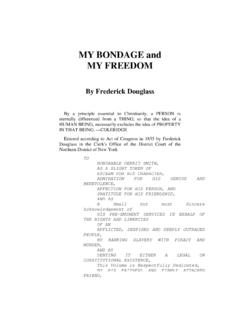Transcription of REMEDIES AGAINST PUBLIC BODIES - Law …
1 The Law CommissionREMEDIES AGAINST PUBLIC BODIESA Scoping ReportThe Law Commission was set up by section 1 of the Law Commissions Act 1965for the purpose of promoting the reform of the Law Commissioners are:The Honourable Mr Justice Etherton, ChairmanProfessor Hugh Beale QC, FBAMr Stuart BridgeDr Jeremy HorderMr Kenneth Parker QCThe Chief Executive of the Law Commission is Steve Humphreys and its officesare at Conquest House, 37-38 John Street, Theobalds Road, London WC1N communications relating to this report or the substantive project should beaddressed PercivalLaw CommissionConquest House37-38 John StreetTheobalds RoadLondonWC1N 2 BQTel: report is available free of charge on our website at.
2 COMMISSIONREMEDIES AGAINST PUBLIC BODIESA SCOPING REPORTCONTENTSPART 1: INTRODUCTION2 PART 2: THE DEVELOPMENT OF THE PROJECT3 PART 3: PUBLIC BODIES AND COMPENSATION10 PART 4: ARE DAMAGES ALWAYS THE ANSWER?32 PART 5: THE SCOPE OF THE PROJECT422 PART 1 INTRODUCTION This report sets out our plans for a substantive law reform project on theremedies available to the individual AGAINST PUBLIC BODIES . We set out ourconclusions on the scope of, and terms of reference for, the project in Part 5below. The origins of this work lie in the reflection and consultation exercise weundertook in preparing our Ninth Programme of Law Reform.
3 The NinthProgramme was published in March 2005, following approval by the LordChancellor. A scoping study, the results of which are contained in this report, wasincluded in that Programme, as a preliminary to a substantive law reform have found the task of delineating a project that was both manageable interms of workload and likely to produce substantive PUBLIC benefit a difficult describe the process by which our thinking on the project has developed inPart 2. Understanding that process is, we think, important in appreciating thenature of the substantive project upon which we will now embark.
4 The purpose of this paper is to delineate the scope of a substantive law reformproject. Given the history of the development of the project outlined in Part 2, wedo not think it desirable to consult further this is a report, not a consultationpaper. We would, nonetheless, be happy to receive any thoughts thatpractitioners, academics or others interested in our subject matter might like tosubmit at any Necessarily, in considering in this report what the scope of the project should be,we have sometimes stated conclusions or taken positions.
5 We emphasise thatany such conclusions or positions are very much provisional and preliminary they do not bind us for the purposes of the substantive project. And, of course,any provisional conclusions we arrive at will be subject to consultation as part ofthe substantive project. We will publish a full-scale substantive consultation paperin due Commission, Ninth Programme of Law Reform (March 2005), paras to should be directed to the PUBLIC Law Team. Contact details are 3 PART 2 THE DEVELOPMENT OF THE PROJECTMONETARY REMEDIES IN PUBLIC LAW Our initial concern was with the availability of monetary REMEDIES in PUBLIC Itwas in this phase that we published (in October 2004)
6 A discussion Thegeneral rule is supposed to be that, on judicial review, damages are The central argument of the discussion paper was that there was acase for saying that a series of autonomous developments in the law had madethat general rule less general, to the point of becoming anomalous. Thosedevelopments were in human rights law, European Union law, and in the liabilityin tort of PUBLIC BODIES (where the impact of the Human Rights Act 1998 andEuropean Union law were themselves having an effect).
7 The limitations on judicial review Since its reformulation with the introduction of Order 53 in 1977, judicial reviewhas been the central procedure for the development of PUBLIC law in England However, its scope is limited. First, the REMEDIES generally available on judicial review are Lord Bingham has suggested extra-judicially that any discretion shouldbe tightly controlled and carefully exercised,5 the fact remains that remediessought in judicial review actions are not available as of right. A second important limitation is the short time limit for claims.
8 A judicial reviewmust be brought promptly and not later than three months after the ground forreview first Although an application within three months may be refused,7there is also scope for the court to extend the three month concern was particularly prompted by a paper by Michael Fordham, "Reparationfor Maladministration: PUBLIC Law's Final Frontier", given at the Government LegalService s annual conference in March 2003 and subsequently published in (2003) 8(2)Judicial Review Commission, PUBLIC Law Team Discussion Paper, Monetary REMEDIES in PublicLaw (October 2004), available 3 The Supreme Court Act 1981, s 31(4)
9 Provides that damages are only available on anapplication for judicial review if a claim for damages is joined to the application and thecourt is satisfied that damages would have been awarded in that amended Order 53 of the Rules of the Supreme Court (now replaced by Part 54of the Civil Procedure Rules) was largely based on the Law Commission Report onRemedies in Administrative Law (1976) Law Com No 73, Cmnd 6407. Much of thisreform was subsequently underpinned by the Supreme Court Act 1981, s 31. 5T Bingham, Should PUBLIC Law REMEDIES be Discretionary?
10 [1991] PUBLIC Law Procedure Rules, r Court Act 1981, s 31(6) and (7).8 Civil Procedure Rules, r (2)(a).4 Finally, and crucially for this project, in general the award of damages is not aremedy available on judicial review. Judicial review does not, therefore, providean avenue for compensation to an applicant who has suffered loss as a result ofan unlawful administrative impact of the Human Rights Act 1998 PUBLIC authorities may now be liable in damages if they are found to havecommitted breaches of individuals human rights contrary to section 6 of theHuman Rights Act 1998.
